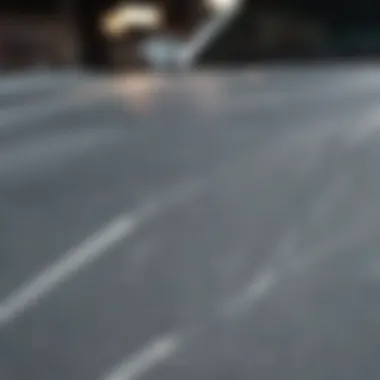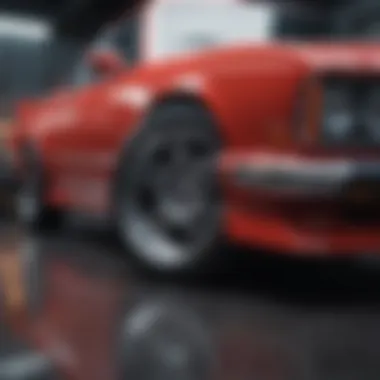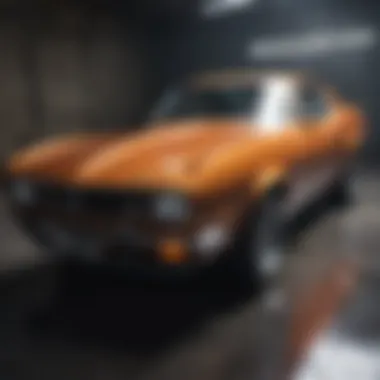Effortless Ways to Remove Scratches from Clear Coat


Intro
Scratches on a vehicle's clear coat can detract from its overall appearance. This creates an urgency among car owners, whether novice or seasoned, to find effective solutions. Clear coats serve as protective layers that enhance the aesthetic appeal and longevity of paint jobs. Therefore, understanding how to remove these scratches is crucial.
In this guide, we will cover various methods and techniques that can help restore the integrity of your vehicle's surface. We will delve into recommended tools, detailed step-by-step procedures, and best practices that will minimize additional damage. With the right approach and accurate information, restoring your car's finish could be achievable and rewarding without expert help.
Understanding Clear Coat and Its Purpose
Clear coat plays a vital role in protecting and enhancing the appearance of automotive finishes. In this segment, we will explore its composition, its importance in vehicle aesthetics, and various other factors that highlight its significance. An understanding of clear coat not only equips car owners with the knowledge needed to maintain their vehicles but also prepares them for tasks that involve the repair and cleaning of scratched surfaces.
What is Clear Coat?
Clear coat is a transparent layer applied over base paint, designed to offer several protective features. Typically composed of acrylic or polyurethane, this top layer shields vehicles from harmful factors like UV rays, oxidation, and environmental contaminants. The thickness of clear coat can vary significantly, often ranging from two to six mils, enabling its role as the armor of the vehicle's paint finish.
The clear coat does not alter the color beneath it; rather, it augments its depth and shine. It is critical to understand that clear coat can absorb minor scratches, helping maintain the aesthetic integrity of paint underneath. This context is essential for car enthusiasts and first-time car buyers who take pride in the looks of their vehicles.
The Role of Clear Coat in Automotive Finishes
Clear coat serves multiple essential functions in automotive finishes.
- Protection: One of the premier benefits is its protective attribute. It prevents damage from elements that can lead to dullness or fading.
- Aesthetic Appeal: The shiny appearance of a well-maintained clear coat enhances the overall look of a vehicle. It gives depth to the paint and elevates the vehicle’s aesthetic quality.
- Durability: Clear coat adds a layer of resilience that can improve the lifespan of the base paint underneath it.
- Easier Maintenance: A smooth clear coat surface minimizes the adherence of debris, making it easier for owners to wash and protect their vehicles over time.
The right maintenance of clear coat can prevent extensive repairs and help in preserving a vehicle's resale value for years to come.
An awareness of clear coat's function reinforces the need for effective scratch removal methodologies. As owners become more informed about this protective layer's purpose and structure, they can implement proactive measures to maintain their vehicles adequately.
Types of Scratches on Clear Coat
Understanding types of scratches is crucial when it comes to removing them effectively from your vehicle’s clear coat. Each category of scratches requires different methods and techniques for repair. Moreover, recognizing the specific type helps in preventing further damage to your car’s finish.
Surface Scratches
Surface scratches are the most common types of scratches encountered. They generally affect only the clear coat layer of the paint system. They are usually light and can be caused by everyday activities such as top of a shopping cart, branches, or gentle impacts. The importance of addressing these scratches is twofold:
- Aesthetic Appeal: Surface scratches can detract from your vehicle's overall appearance.
- Chemical Protection: The clear coat acts as a shield against harmful elements. Left untreated, surface scratches can allow contaminants to degrade the underlying paint.
Treatment for surface scratches can often be achieved using simple polishing compounds and applicators designed for addressing such marks. The method involves removing a thin layer of the clear coat to level out the scratched area without affecting the rest of the finish. Hence, precise identification of the scratch type ensures that one applies the right technique, maintaining the integrity of the automotive surface.
Deeper Scratches
Deeper scratches, however, penetrate beyond the clear coat and may reach the paint layer underneath. These scratches are more serious and need careful evaluation. They can be caused by more aggressive incidents like contact with sharp objects or gravel on the road.
Addressing these scratches often requires a more thorough approach:
- Assessment of Scratch Condition: Before proceeding with repairs, it is essential to evaluate the scratch's depth and extent.
- Repair Techniques: Options vary from touch-up paint to professional refinishing, depending on the damage level.
- Potential Maintenance: Deeper scratches that are not treated promptly could lead to rust or paint fading. Thus, recognizing early indications of deeper scratches is significant to protect your vehicle’s life span.
In closing this section, understanding the distinctions between surface and deeper scratches empowers car owners to make informed decisions about scratch repair. This awareness ensures the beauty and longevity of the vehicle’s finish, while educating on necessary action and appropriate use of products.
Assessing the Damage
Before delving into scratch removal techniques, it is essential to assess the damage thoroughly. Knowing what kind of scratches exist on your vehicle helps you choose the appropriate repair methods. When you correctly evaluate the condition of the clear coat, it can save you time and avoid further harm during the repair process.
Accurately analyzing the scratches allows you to determine whether they can be addressed with do-it-yourself methods or if professional help is necessary. Scratches also vary in depth and severity. Understanding this can guide your decisions, ensuring that you do not damage the clear coat and the paint beneath it while trying to restore your vehicle's appearance.


Identifying Scratch Depth
To begin, you need to identify how deep the scratches are on your clear coat. This assessment is crucial because different depths require distinct methods of correction. Surface scratches generally affect only the clear coat layer without reaching the paint. You can often remediate them using polishing compounds.
However, deeper scratches can penetrate past the clear coat, damaging the paint underneath. In these cases, you may need to pursue more extensive repair techniques, such as touch-up paint application or seeking professional assistance.
To assess scratch depth:
- Examine Under Good Lighting: Utilize bright light to enhance visibility. This condition enables you to distinguish between light surface marks and deeper gouges clearly.
- Fingernail Test: Lightly run your fingernail over each scratch. If your nail catches, the scratch is likely too deep for simple polishing.
- Observe for Paint Damage: Brush dirt or dust away from each area. If you see the base color of the paint layer instead of just the clear coat, the scratch has gone deeper and needs special attention.
Determining Repair Feasibility
Once you identify the depth of the scratches, the next step involves determining the feasibility of repair. Not every scratch is suitable for DIY fixes, so assessing a scratch's potential for success is vital in the overall scratch-removal process. Various factors come into play here.
Consider the following factors before undertaking any repairs:
- Severity of Damage: Minor surface scratches can usually be resolved at home. However, if scratches are severe or widespread, professional repair may be safer, preserving the integrity of your vehicle's finish.
- Tools and Resources: Evaluate if you possess the right tools for the job, such as polishing compounds, applicators, and buffers. If lacking, it might be better to hire someone skilled.
- Cost-Benefit Analysis: Perform a cost analysis regarding possible repairs or services and the potential outcomes. Sometimes trying to fix deep scratches can lead to more expenses in the long term.
A thorough assessment significantly influences the final appearance of your vehicle’s clear coat.
In summary, assessing the damage sets the foundation for successful scratch removal. Understanding the depth and repair feasibility allows you to tailor your approach for optimal results.
Essential Tools and Materials
Understanding the essential tools and materials is crucial for anyone looking to remove scratches from automotive clear coat. Each tool plays a specific role in the scratch removal process, ensuring effective outcomes while minimizing the risks of further damage. Utilizing appropriate tools enhances the efficiency of the task at hand, which is why knowing what to use and how to use it is key. Here, we explore three fundamental components: polishing compounds, applicators and buffers, and microfiber cloths.
Polishing Compounds
Polishing compounds are the foundation of scratch removal, containing abrasives that help level the surface of the clear coat. Different types exist, each suited for specific scratch depths. Fine polishing compounds are ideal for superficial scratches, while heavier ones might be required for deeper issues. Choosing the mmost suitable compound ensures that the scrub results are effective without damaging the clear coat itself. Many professionals recommend compounds from reputable brands like 3M or Meguiar’s due to their proven reliability in automotive care. As immediate outcomes can sometimes vary, it is recommended to test on an inconspicuous area first to ensure compatibility.
Applicators and Buffers
Applicator pads and buffers deliver the polishing compounds onto your vehicle's surface. Each serves its own purpose: pads create the correct application technique, and buffers speed up the shine process. The choice between a machine buffer and a hand applicator largely depends on the size of the area you are working on and your proficiency level. Electric buffers can effectively cover larger areas quickly but carry a risk of over-buffing if not handled carefully, wherehand applicators offer more control to novice users. Having various types on hand allows flexibility in method and approach.
Microfiber Cloths
Microfiber cloths are essential for both application and removal to prevent further scratching. Their unique fiber structure effectively traps and lifts debris without roughing up the clear coat layers. The use of clean microfiber cloths ensures that any compounds or excess polish are thoroughly eliminated without introducing new scratches. It is highly advisable to keep a supply of different sizes for various tasks, like cleaning the surface before starting or buffering during the process.
Using quality tools can significantly enhance your vehicle's appearance while maintaining its integrity.
By having the right tools and materials, the scratch removal process becomes not only efficient but also effective, leaving your vehicle looking its best.
Step-by-Step Scratch Removal Techniques
Understanding how to effectively remove scratches from a clear coat is vital for maintaining the vehicle's appearance and value. The process requires careful execution to avoid further damage. In this section, we will detail the practical methods for restoring clear coat finishes through systematic techniques that enhance both the look and durability of your vehicle's surface.
Washing the Affected Area
Before you start any scratch removal process, washing the area is crucial. Cleaning the surface ensures that any dirt and debris are removed, which minimizes the risk of causing more scratches during treatment. Use a mild car shampoo and a soft sponge or cloth to effectily wash the area,
- Rinse off any loose debris with water.
- Clean with soapy water, avoiding household cleaning agents as they can be harsh.
- Thoroughly rinse and dry with a microfiber towel.
Proper washing prepares the surface for subsequent steps and promotes better adhesion when using polishing compounds.
Applying Polishing Compound


Applying a suitable polishing compound is a key step. Choose a compound specifically meant for clear coat finishes. A small, controlled amount is often most effective.
- Use a foam applicator pad for this step.
- Apply the compound directly onto the pad and work it into the scratched area using a straight motion.
- Use light pressure to avoid damaging the clear coat further.
Even a professional-grade polishing compound needs patience. Over-application can cause more harm than good, so make sure you follow instructions specific to the product being used.
Buffing the Surface
Once the polishing compound is applied, buffing is the next critical phase. This process helps in blending the compound into the surface. Ensure you tiake your time here.
- Use a clean microfiber cloth or an electric buffer, depending on your comfort level.
- Sweep back and forth evenly across the area until the residue has mostly disappeared.
- Avoid focusing in one spot for too long to prevent overheatingpatches.
Buffing brings out a shine and helps clear out any remaining particles or residues that could impact the finish.
Inspecting the Results
After completion of polishing and buffing, inspecting the results becomes essential. This step will confirm whether the scratch has been effectively managed. Take note of:-
- Look at the area in different lighting conditions.
- Check for any remaining scratch marks or imperfections.
By taking a proper, detailed inspection, you can determine if further work is needed or if the vehicle is ready to take on the road once again.
Consistency and attention to detail are critical in the scratch removal process. Omitting any steps can lead to unsatisfactory results.
In summary, following these distinct steps not only enhances the appearance of the vehicle but also contributes to its longevity. Ample focus on these procedures can lead to successful outcomes in maintaining your automotive's clear coat.
Common Mistakes to Avoid
Removing scratches from clear coat finishes often appears straightforward, yet many enthusiasts encounter issues due to certain common mistakes. Understanding these pitfalls is vital. It not only helps avoid potential damage to your vehicle but also ensures a more effective restoration process. In this section, we will examine three significant mistakes and their implications for clear coat care.
Using Inappropriate Tools
One of the most critical missteps in scratch removal is the use of inappropriate tools. Using the wrong tools can cause unintended harm to the clear coat. Many assume that any buffer or abrasive will suffice for polishing, but this is misleading. For instance, low-quality buffers may produce uneven results. Similarly, using steel wool can scratch the surface instead of smoothing it.
Stick to pads designed explicitly for clear coat finishes. Foam, microfiber, or foam pads with a soft touch can offer better results. Ensure the chosen tools are compatible with the polishing compounds you plan to use. The correct tool selection can significantly affect the end result, enhancing the risk of damage if not prioritized.
Skipping the Wash Step
A common oversight many make is bypassing the washing step before applying any products. Skipping the freeze can lead to serious consequence—dirt, dust and grime can scratch the surface further during polishing. The presence of debris can worsens existing scratches. Therefore, it’s crucial to wash the affected area thoroughly before treatment.
Use a gentle car soap and a grime-free wash mitt. Allow the car’s surface to dry completely prior to work. This guarantees that you don’t drag contaminants across the surface while buffing, protecting both the clear coat and the underlying paint. Skipping this step heightens the chance of deeper scratches forming, complicating future corrections.
Over-Buffing
Another fundamental mistake is over-buffing the area, which can lead to a diminished clear coat. Every clear coat has a certain thickness, and excessive buffing can wear through this layer, exposing the underlying paint. It happens when one feels compelled to achieve total perfection. However, this should be avoided at all costs.
Rather than continuous sessions of buffing, it’s better to assess the outcome often. Inspect the area after each buffing iteration. If scratches remain, assess the properties of the polishing product used and consider an alternative rather than extending buffing unnecessarily. This practice helps protect the clear coat's integrity while still working toward achieving your aesthetic goals.
Learning from the mistakes of improper tool usage, washing protocols, and buffing techniques is essential in maintaining a vehicle's clear coat effectively.
Preventive Measures for Future Scratches
Preventing damage to a vehicle's clear coat is as crucial as repairing it. Understanding how to avoid scratches not only preserves the aesthetic appeal of your car, but also helps maintain its value over time. Investing time and resources in preventive measures is significantly less taxing than dealing with scratches later. It is a proactive approach that every car owner should consider in their vehicle maintenance routine.
Regular Maintenance and Cleaning


One of the most effective ways to prevent scratches is through regular maintenance and cleaning. A clean surface reduces the risk of dirt and debris causing damage when washing or drying the car. Here are few key points to consider:
- Frequency of Washes: Washing your vehicle regularly will remove dirt and grime that can scratch the clear coat. Aim for a thorough wash every two weeks, and more often if conditions permit.
- Proper Washing Technique: Always use the two-bucket method for washing. One bucket should be for the soapy water and the other for rinse water. This prevents dirt from scratching the clear coat while washing.
- Use Non-Abrasive Materials: Choose soft wash mitts and microfiber towels. These materials help in lifting dirt without causing damage to the clear coat.
Regular cleaning creates a protective barrier that minimizes the risk of scratches and maintains your vehicle's pristine appearance.
Using Protective Coatings
Another practical measure for preventing scratches is applying protective coatings. These coatings create a physical barrier between the clear coat and the environment. There are various options available, which include:
- Ceramic Coatings: These provide a durable layer of protection. They can last for several years, protecting against scratches and other environmental damage.
- Sealants: Synthetic paint sealants can also help. They generally last fewer months than ceramic coatings but are easier to apply and more cost-effective.
- PPF (Paint Protection Film): This is a thicker layer that provides extensive coverage. It can absorb impacts from road debris, thus greatly reducing the risk of scratches.
By thoughtfully considering these options, you can increase your vehicle's resilience against potential damage.
Regular maintenance and the right protective coatings can help in substantially reducing scratch incidences and prolonging the life of clear coat finishes.
When to Seek Professional Help
Recognizing when to seek professional assistance for scratch repair is vital for preserving the integrity of your vehicle's clear coat. Although techniques exist for do-it-yourself repair, some scenarios require expert intervention to avoid further damage. Knowing the right moment to consult a professional can save both time and money in the long run.
Assessing Damage Beyond DIY Repair
Determining whether a scratch can be repaired at home often involves evaluating its depth and extent. If the scratch only affects the clear coat and does not penetrate to the paint layer, you may wish to attempt fixes personally. However, serious damage may warrant professional help.
Signs that indicate a professional repair might be necessary include:
- Scratches that are measurable; noticeable drops or indents in the clear coat.
- Scratches enhancing the car’s color or visible layers beneath. Commonly known as primer or base coat.
- A surface area larger than ten inches.
Professional-grade tools and expertise offer solutions that may not be available to most casual car owners. Misjudging the depth could therefore lead to improper repairs that degrade the clear coat's overall appearance.
Choosing a Reputable Service Provider
When you decide it is time to get professional help, selecting the right service provider is next and important step. Not all automotive shops have the same credentials or equipment needed for scratch removal. Consider asking the following when searching for a reputable service:
- What experience do they have? Experience can indicate both quality and reliability.
- Are they certified or affiliated with recognized automotive organizations?
- What kind of warranty do they offer for their work? This establishes some security in case of mistakes.
- Looking up previous customer reviews through platforms like Reddit or Facebook can also reveal valuable insights.
A careful choice may lead to work done not only with skill but also with care for your vehicle's aesthetics. The results can enhance rather than detract from your vehicle's appeal, preserving its value.
Misjudging the depth of scratches might lead you to costly repairs that are further unnecessary, so wise choices matter.
By knowing when to reach out for professional help, you position yourself to maintain your vehicle properly, along with still conserving its value through well-executed repairs.
Ending
In this article, we emphasized the significance of efficiently removing scratches from clear coat finishes on vehicles. The appearance of a car speaks volumes not only about the owner's pride but also about the condition of the vehicle itself. Scratches, although common, can detract from that aesthetic and reduce resale value.
Recap of Scratch Removal Techniques
We've discussed various methods to restore the clear coat, ranging from using specialized polishing compounds to effective buffing techniques. It is essential to match the method to the depth and severity of scratches encountered. Remember the following key techniques:
- Wash the affected area thoroughly before any cleaning or polishing.
- Select the right polishing compound, as this will ensure that you do not damage the clear coat further.
- Be precise while buffing, using a consistent motion to spread the product evenly.
- Finally, always inspect the results and assess if the scratch is effectively removed.
Implementing these techniques can significantly rejuvenate the surface of your vehicle while safeguarding its value.
Final Thoughts on Vehicle Care
Vehicle maintenance goes beyond fuel and oil checks. Understanding the importance of the clear coat is a vital part of protective measures for your car. Avoid neglecting minor scratches, as they can expand if left unattended.
- Regular washes using appropriate products will help maintain the clear coat’s integrity.
- Using waxes and deeper protective coatings will not only enhance shine but also defend against future scratches.
- It’s not only the aesthetics that are improved; preventive measures can save significant costs in the long term.
Car care, especially maintaining the clear coat, is a balance of knowledge and approach. Armed with the strategies in this article, any enthusiast or first-time buyer can take their vehicle's appearance to the next level while enjoying the process.













